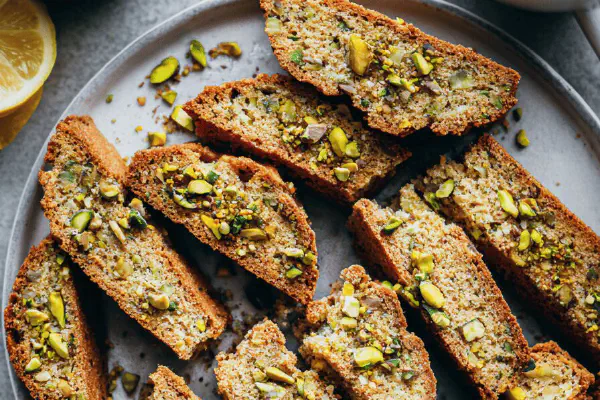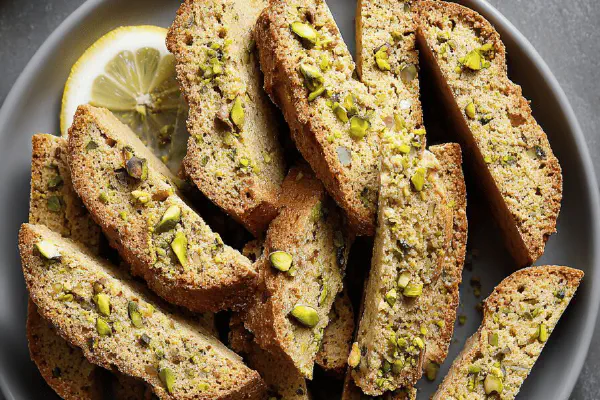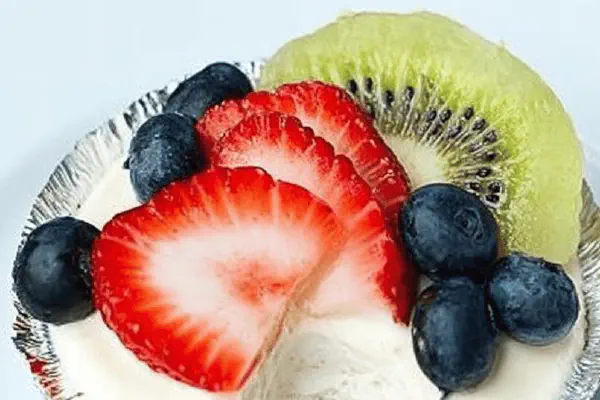Vegan Pistachio Lemon Biscotti

By Emma
Certified Culinary Professional
Ingredients
- 200 g (1 1/3 cups) unbleached all-purpose flour
- 90 g (7 tbsp) granulated sugar
- 1/2 tsp baking powder
- 1/4 tsp baking soda
- 70 g (1/2 cup) roasted shelled pistachios
- 125 ml (1/2 cup) almond milk vanilla flavored
- 60 ml (1/4 cup) neutral vegetable oil
- 1 lemon, finely grated zest
About the ingredients
Method
- Preheat oven to 175°C (350°F). Position rack mid-oven. Line baking tray with parchment or silicone mat.
- In a bowl, stir together flour, sugar, baking powder, baking soda, and pistachios. Mix well to evenly distribute.
- Add almond milk, oil, and lemon zest. Use hands lightly dusted with flour—dough should be firm but pliable. If too wet, dust a little more flour, but resist overmixing.
- Shape dough on tray into a long rectangle about 28 x 10 cm. Don’t worry about perfect edges; rustic is fine. Press down just to even thickness.
- Bake 28–32 minutes. Look for light golden top, edges pulling slightly away from tray. Insert toothpick: should come out mostly clean. Let cool 5 minutes on tray, then transfer to counter to cool 10 minutes more.
- Using serrated bread knife, slice into 1 cm thick pieces. Don’t force or crumble will happen. Arrange slices cut side down spaced apart on tray.
- Back in oven for second bake, approx 15-18 minutes turning halfway. Watch for golden-brown edges, dry and crisp texture. Should snap clean when tested.
- Cool completely on rack before storing. Keeps several days in airtight container, good dunked, or crumbled over coconut yogurt.
Cooking tips
Chef's notes
- 💡 Flour balance tricky - small shifts fix dough dryness or excess moisture, but eyeball feel most reliable. Dough should be firm, not sticky or wet, dust hands and surface lightly with flour. Resist adding too much or bakes tough. For slicing, let first bake cool then cut with serrated knife carefully; forcing crumbs.
- 💡 Watch oven heat carefully; rack mid prevents burnt bottoms and uneven cooking. Golden edges show readiness, toothpick test for crumb doneness. Listen for quiet snap on second bake. If edges too dark before center bakes, lower heat or rotate tray early. Cooling fully important; hot biscotti crumble or bend, lose that crunch.
- 💡 Use vanilla almond milk over oat coffee milk swap for cleaner flavor, less grainy. Neutral oil needed—vegetable or canola preferable to avoid overpowering olive or coconut oil flavors. Toast pistachios lightly but watch close; burnt nuts ruin overall bite, keep rustic chunk texture by adding as is.
- 💡 Lemon zest must be freshly grated, none of that pre-packaged dried stuff. It’s aroma and brightness anchor. Add zest last with liquids; mix quickly to avoid overworking dough which toughens gluten. Dough texture feels crumbly but binds well—don’t overload flour. Dough shape: no rolling pin, form rough rectangle on tray, just even thickness.
- 💡 Second bake timing varies slightly; 15 to 18 minutes turning halfway works best. Watch color—edges go golden-brown, texture dry and crisp. Overbake and biscotti toughen too much. Let cool fully on rack before storage. Biscotti age well when stored airtight, dunking improves as they dry further. Old biscotti break crisply, great for crumbling.
Common questions
Can I substitute almond milk?
Yes, use soy, oat, or rice milk. Texture shifts slightly but still works. Vanilla flavor smooths other plant milks. Watch dough moisture; adjust flour if too sticky. Nut flavor reduced with neutral milks like oat.
Dough too sticky how to fix?
Add flour very gradually, dust hands and surfaces to ease shaping. Avoid mixing too much after liquid incorporation to prevent toughness. Refrigerate briefly if too soft before shaping. Sticky dough crumbles on slicing; dry feel better.
Baking soda purpose?
Provides subtle lift and crumb lightness missing with no eggs. Doesn’t change flavor much but cuts density. Baking powder alone lacks that crumb openness. Skip soda and biscotti denser but still edible. Balance both for best results.
How to store biscotti for freshness?
Airtight container room temp standard. Can freeze but texture shifts, thaw fully before crisping in low oven. Keep away from humidity or they'll soften fast. Older biscotti better dunkers but if stale, toast for revival. Avoid fridge storage; moist air ruins crunch.



